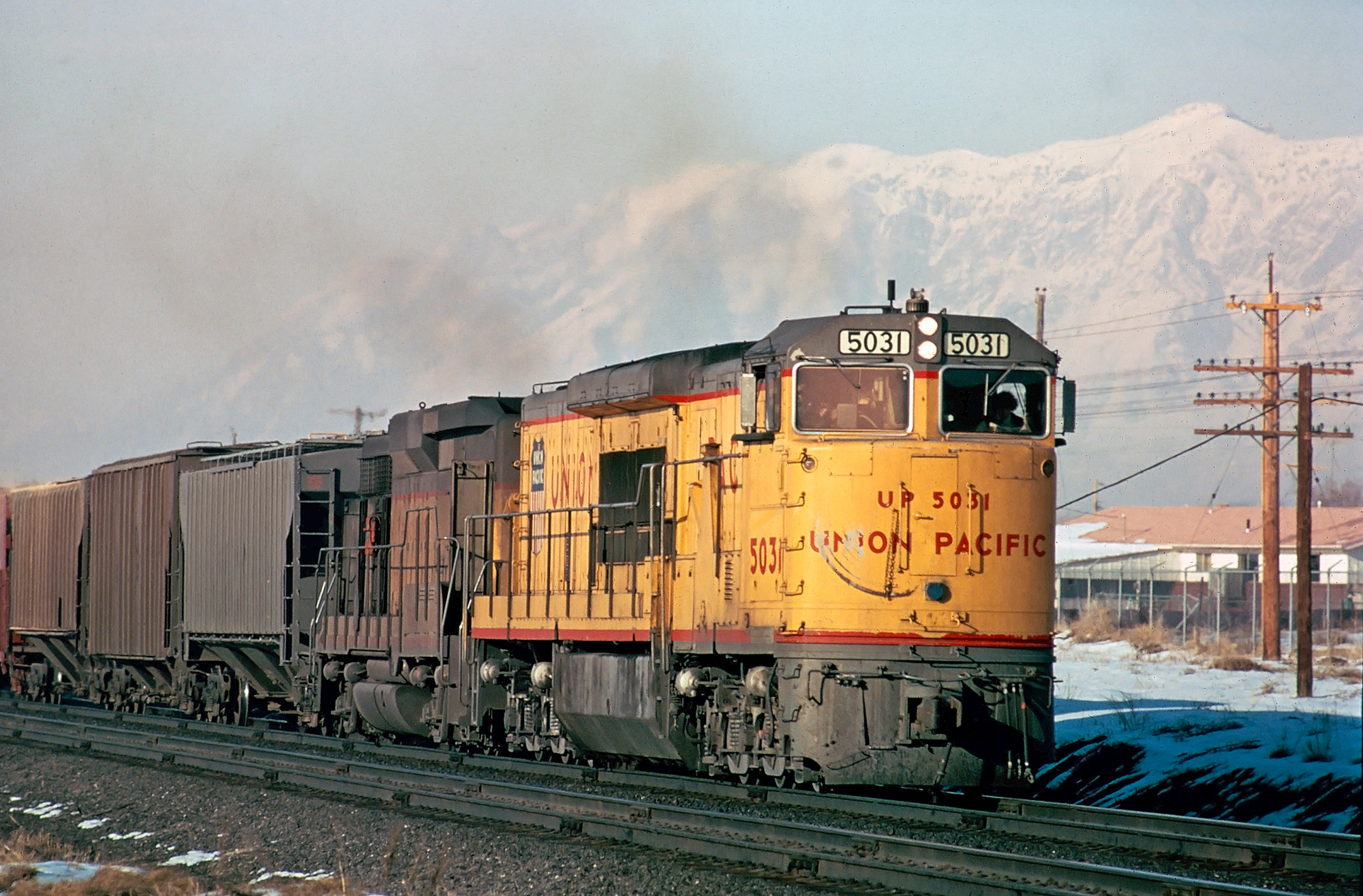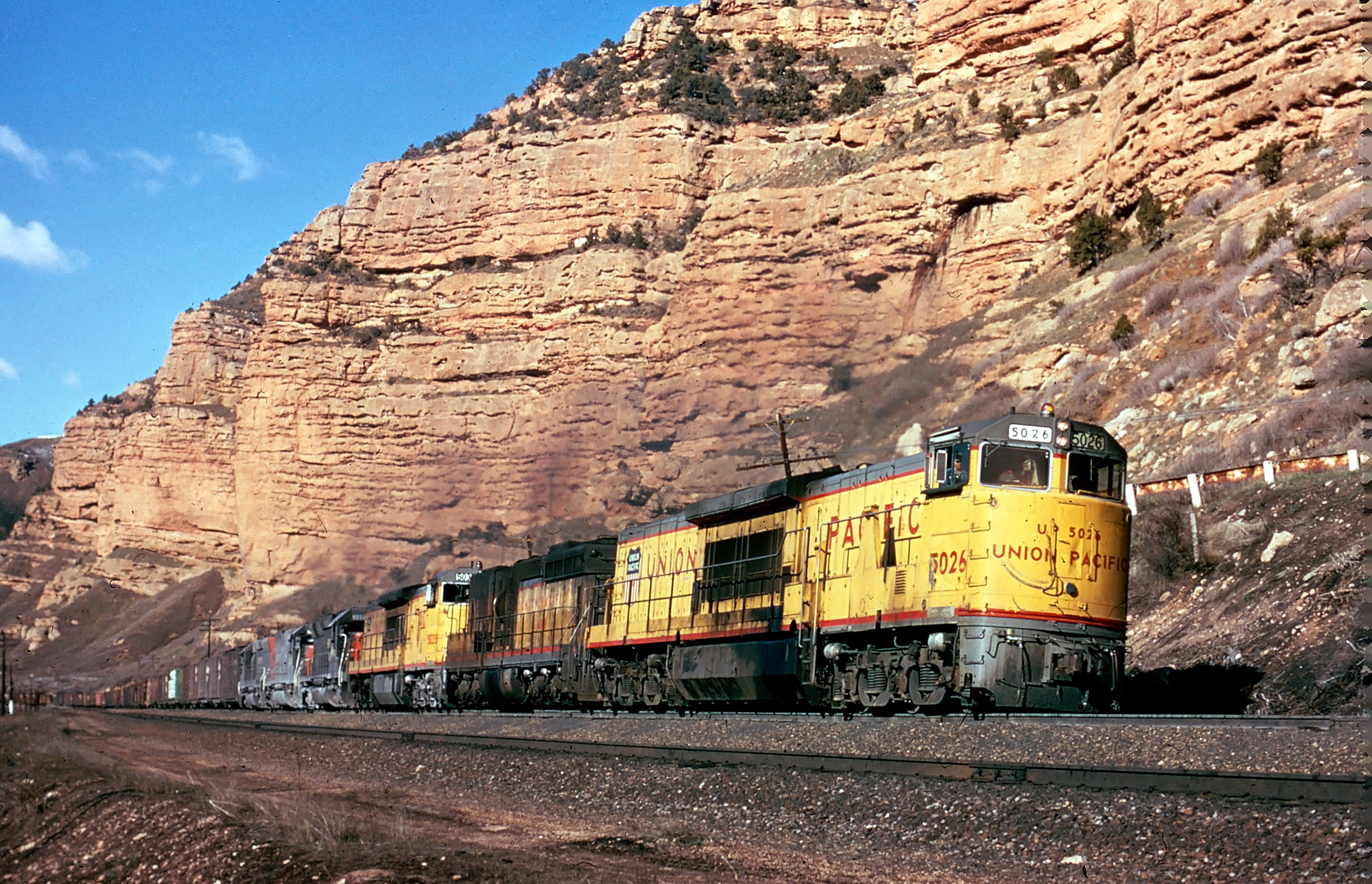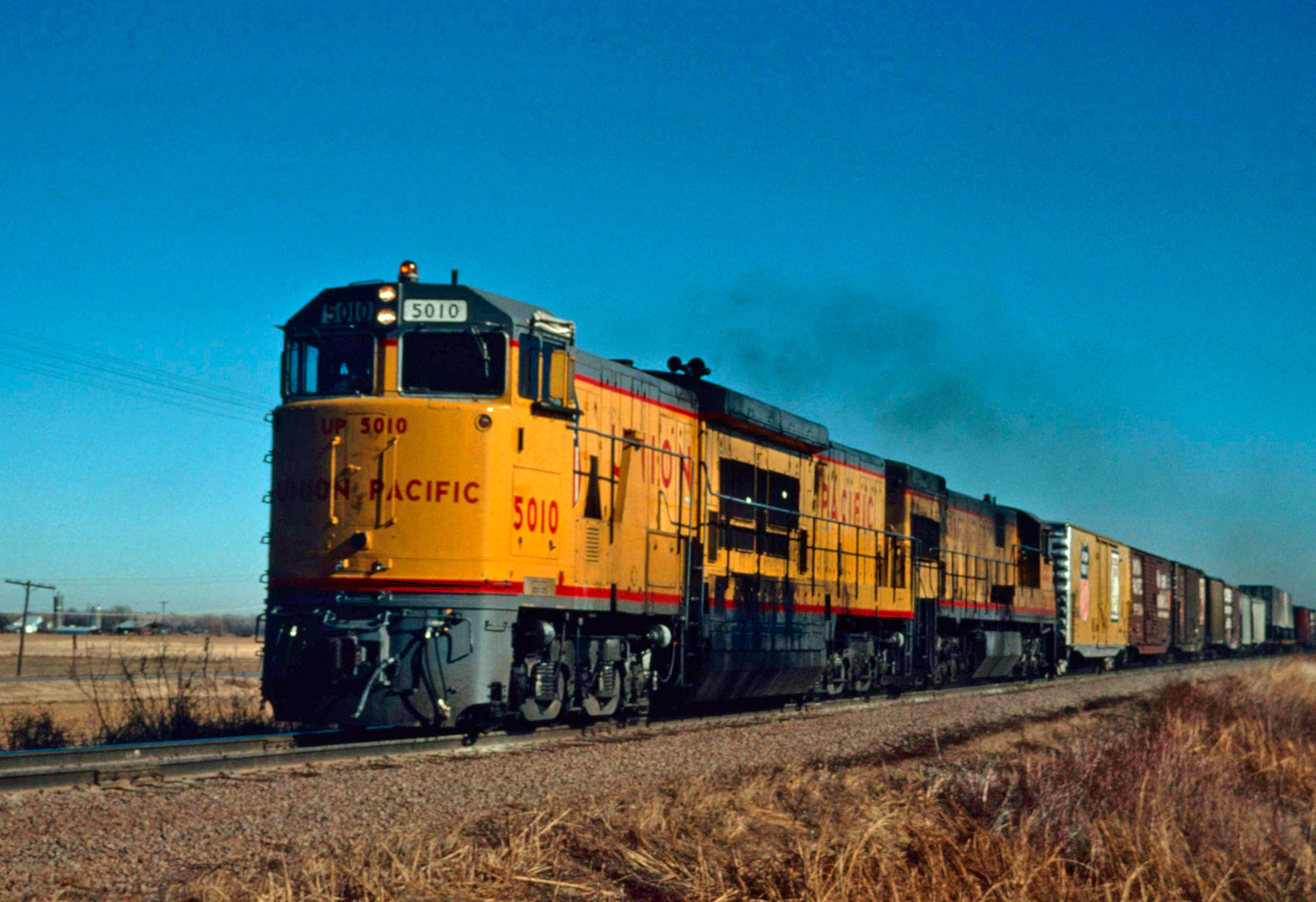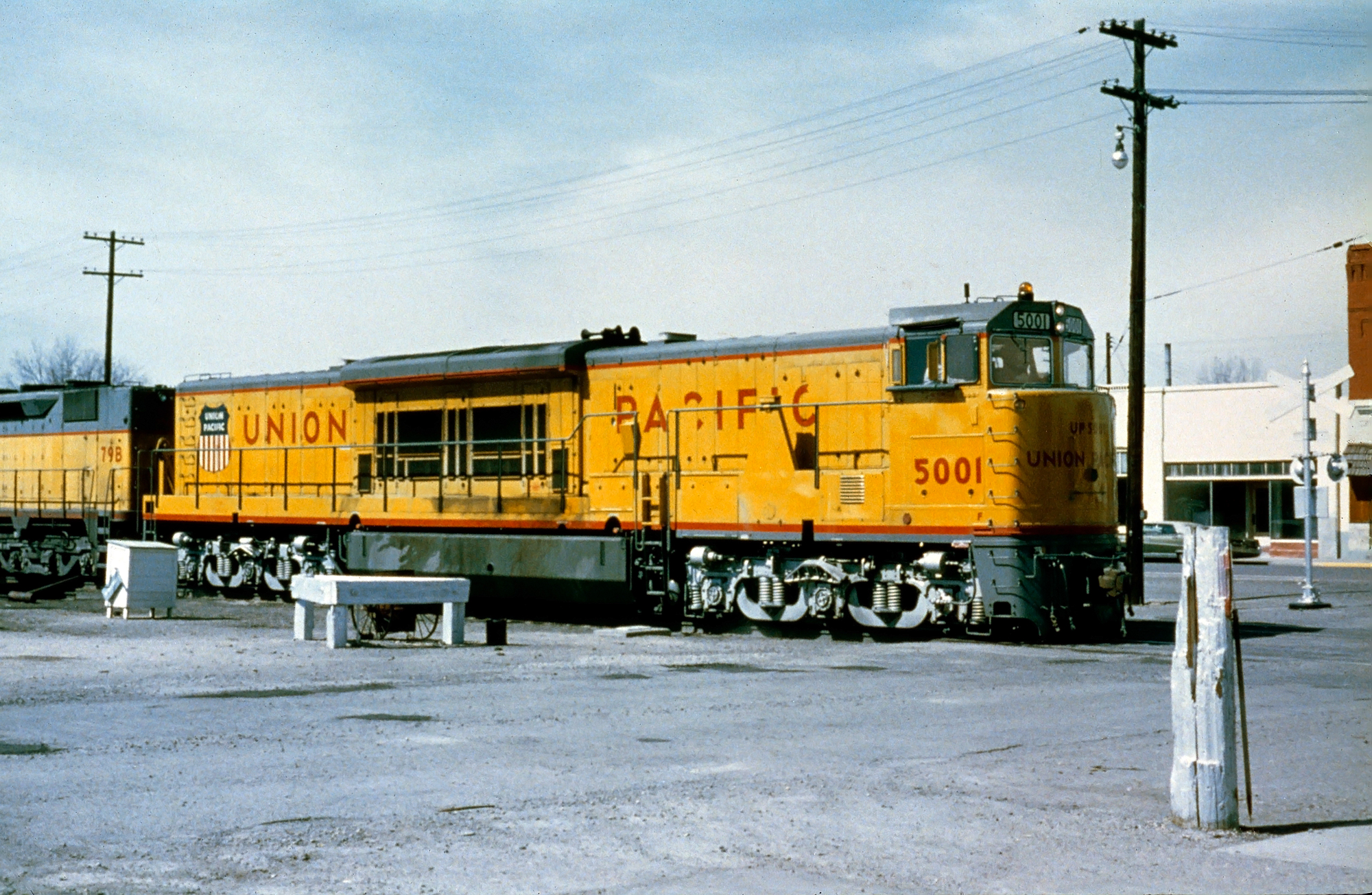GE "U50C" Locomotives: Specs, Horsepower, History
Last revised: December 31, 2024
By: Adam Burns
The U50C was General Electric's successor to its earlier U50 design of 1963. As Brian Solomon notes in his book, "GE Locomotives," improvements with the 7FDL prime mover enabled the company to offer this high horsepower variant with 12-cylinder power plants in place of the standard 16.
In doing so, the U50C offered lower maintenance costs and better fuel economy. Nevertheless, it still proved a shaky design and the fleet operated for less than 10 years before retirement.
History
While the 1960s are often remembered as the great horsepower race between Alco, GE, and EMD there was another ongoing by an individual railroad, Union Pacific.
That decade saw the western carrier experimenting with numerous one-off designs like the C-855, DH-643 (diesel hydraulic), DD35 and DD35A, U50, U50C, gas turbines (GE/Alco products), and the DDA40X.
All of these locomotives offered horsepower ratings of 5,000 or greater (except for the 4,300 horsepower DH-643) as UP sought a locomotive that could reduce operating costs.
Most were essentially two locomotives under a single hood (duel powerplants), and not particularly successful. There were two exceptions, the gas turbines and EMD's variants (DD35 and DDA40X) which were successful and spent many years in service.
Photos
 Union Pacific U50C #5031 and a GP30B in service near Ogden, Utah, circa 1974. American-Rails.com collection.
Union Pacific U50C #5031 and a GP30B in service near Ogden, Utah, circa 1974. American-Rails.com collection.The U50C's use of 12-cylinder engines, and sporting a pair of C-C trucks (requisitioned from aging gas turbines), enabled the locomotive's length to be reduced by 4 1/2 feet over the earlier U50 design.
As Louis Marre notes in his book, "Diesel Locomotives: The First 50 Years," GE engineers completely changed the layout of interior components in the U50C; its radiators were located in the center with the generators near the end. The U50's, by contrast, were placed in the opposite locations.
Top Speed
The U50C was designed for speed and could operate at 80 mph, slightly faster than most standard line U-boats which were rated at 70 mph.
While the U50 weighed in at 558,000 pounds (279 tons), the U50C weighed just 417,000 pounds (208 1/2 tons). This reduction, an impressive 70 1/2 tons, greatly reduced wear on the track and roadbed.
 Union Pacific U50C's (along with an SD24B) and Southern Pacific SD45's (along with an SD45T-2) lead an eastbound freight through Utah's Echo Canyon, circa 1974. American-Rails.com collection.
Union Pacific U50C's (along with an SD24B) and Southern Pacific SD45's (along with an SD45T-2) lead an eastbound freight through Utah's Echo Canyon, circa 1974. American-Rails.com collection.Unfortunately, it did little to remedy the locomotive's other design flaws, most notably the use of aluminum wiring in the electrical system, which easily caught fire.
GE engineers scrambled to correct this problem, which proved so severe that fire to four new units in 1974 caused their near immediate retirement.
The builder looked to potentially have the wiring replaced with copper, a project that would have been outsourced to Morrison-Knudsen. Unfortunately, this proved too expensive to carry out.
 General Electric U50C #5010 leads a general merchandise westbound at Salina, Kansas on January 16, 1976. American-Rails.com collection.
General Electric U50C #5010 leads a general merchandise westbound at Salina, Kansas on January 16, 1976. American-Rails.com collection.As it turned out, fire wasn't the only major issue; the former GTEL trucks proved insufficient to handle the locomotive's weight, as cracks were later discovered in these frames. It seems that every conceivable problem was happening with the U50Cs.
Aside from the issues mentioned above the locomotives also suffered from dynamic brake issues, oil pressure problems, and leaking water coolant.
Perhaps Union Pacific regretted ordering such a large batch of these experimental locomotives (40) although likely trusted General Electric's ability to correct the issues.
Data Sheet and Specifications
| Entered Production | 10/1969 (Union Pacific #5000) |
| Years Produced | 10/1969 - 11/1971 |
| GE Class | U50C |
| Engine | 7FDL12 (2) |
| Engine Builder | General Electric |
| Horsepower | 5,000 |
| RPM | 1050 |
| Length | 79' 0" |
| Height (Top Of Rail To Top Of Cab) | 15' 10 3/4" |
| Width | 9' 11" |
| Weight | 417,000 Lbs |
| Fuel Capacity | 6,000 Gallons |
| Air Compressor | 3CDC (Westinghouse) |
| Air Brake Schedule | 26L (Westinghouse) |
| Trucks | C-C |
| Truck Type | GTEL8500 |
| Truck Wheelbase | 14' 6" |
| Wheel Size | 40" |
| Traction Motors | 752 (6), GE |
| Traction Generator | GT588, GE |
| Auxiliary Generator | GY27, GE |
| MU (Multiple-Unit) | Yes |
| Dynamic Brakes | Yes |
| Gear Ratio | 74:18* |
| Tractive Effort/Starting | 109,000 Lbs |
| Tractive Effort/Continuous | 88,000 Lbs at 10 mph |
| Top Speed | 80 mph |
* The gear ratio could not be verified among the available sources in my collection. The ratio listed may not be correct. The locomotives were rated at 80 mph running according to Mr. McDonnell's book.
Production Roster
(Total Built = 40)
| Owner | Road Number | Serial Number | Order Number | Completion Date | Quantity |
|---|---|---|---|---|---|
| Union Pacific | 5000-5002 | 37139-37141 | 5000 | 10/1969-11/1969 | 3 |
| Union Pacific | 5003-5011 | 37142-37150 | 5000 | 3/1970-5/1970 | 9 |
| Union Pacific | 5012-5016 | 37151-37155 | 5000 | 11/1970-12/1970 | 5 |
| Union Pacific | 5017-5019 | 37156-37158 | 5000 | 1/1971-2/1971 | 3 |
| Union Pacific | 5020-5039 | 37273-37292 | 5005 | 5/1971-11/1971 | 20 |
Sources
- Marre, Louis A. Diesel Locomotives: The First 50 Years, A Guide To Diesels Built Before 1972. Milwaukee: Kalmbach Publishing Company, 1995.
- McDonnell, Greg. U-boats. Toronto: Stoddart Publishing, 1994.
- Pinkepank, Jerry A. Diesel Spotter's Guide. Milwaukee: Kalmbach Publishing Company, 1967.
- Solomon, Brian. GE Locomotives: 110 Years Of General Electric Motive Power. St. Paul: MBI Publishing, 2003.
 Union Pacific U50C #5001 and DD35 #79B at Kearney, Nebraska, circa 1975. Bob Hicks photo. American-Rails.com collection.
Union Pacific U50C #5001 and DD35 #79B at Kearney, Nebraska, circa 1975. Bob Hicks photo. American-Rails.com collection.Final Years
While its Universal line did have its issues, and GE had yet to reach EMD's level of ruggedness or efficiency, the company backed all of its product with warranties and field work.
In the end, nothing could be done to correct the U50C's problems; #5000-5017 were retired in March, 1977 and remaining units scrapped in February, 1978.
Despite the many setbacks, these unique U-boats they were an interesting footnote in the high horsepower race of the 1960's. Alas, none were preserved.
Recent Articles
-
Minnesota Railroad Museums: A Complete Guide
Apr 22, 25 12:17 PM
The state of Minnesota has always played an important role with the railroad industry, from major cities to agriculture. Today, several museums can be found throughout the state. -
Massachusetts Railroad Museums: A Complete Guide
Apr 21, 25 11:41 PM
There are a handful of museums located in the state of Massachusetts detailing its long and storied history with trains, which can be traced back to the industry's earliest days. -
Maryland Railroad Museums: A Complete Guide
Apr 21, 25 01:36 PM
The state of Maryland is where it all began with the Baltimore & Ohio. Along with the B&O Railroad Museum, several other similar organizations can be found in the state.